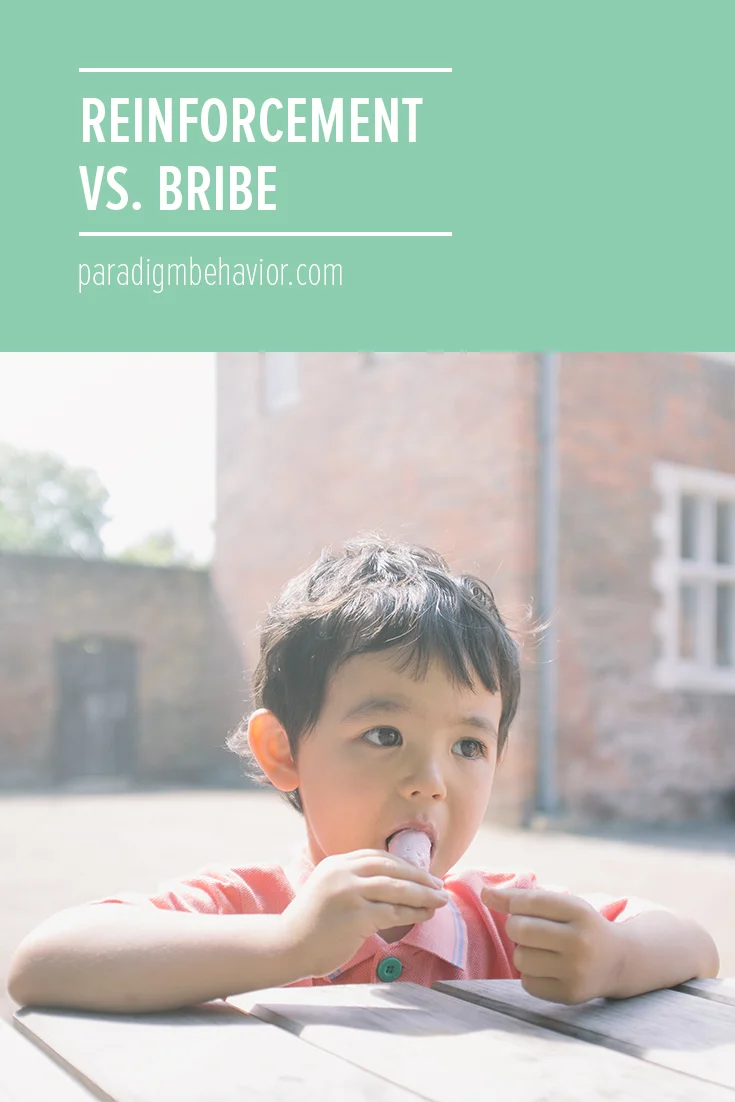ABA sometimes gets a bad rap when it comes to motivating a person to perform a skill. It is often said that we bribe our clients into doing something they don't want to do, when we’re actually using reinforcement to motivate them.
So, what’s the difference?
There are many explanations of how behavior analysts separate reinforcement from a bribe. You can find some examples here and here.
From my perspective, I see a bribe as a selfish act in that it is done more for personal gain rather than affecting behavioral change. I also believe that in the long run, bribery does more harm than good. As an example, what if I offered your child $10 to tell you they had an awesome session with me? Yes, the child got $10, and yes, I came away with a great testimonial, but I would probably have to fork over $10 every session with some serious consequences:
1. It's unethical
2. The client is not gaining any skills
3. I'm not practicing the skills I know
Long term, this bribe isn't making any lasting behavior changes. I should have done my job, and, hopefully, we would have made progress toward our goals.
Now let's look at how positive reinforcement works.
For example, say your child has trouble understanding math. Also, say your child loves to play the game Twister, especially with two people.
I believe we can put these two together in a simple if/then statement.
If you complete your math homework, then I'll play a game of Twister with you.
That's easier said than done, but it's a good start. Math may not be your child's strong suit, so we prompt, provide assistance, and make the homework less challenging to make the task of completing homework achievable.
There are many components to reinforcement such as, Is the game of Twister worth completing my math homework? If we can make the components work, like teaching your child how to complete math homework if they really want to play Twister, then I'd say we were successful at providing positive reinforcement.
Now let's think about the results of positive reinforcement in this example:
1. Your child got some tutoring (prompting)
2. Your child completed their math homework (achieved goal)
3. Your child thinks their tutor is cool because they bonded over Twister (rapport building)
In this scenario, there was a sense of trust that was built in what we typically called "rapport building." Although the therapist made your child complete their homework, your child felt supported throughout the process. Additionally, your child could confidently mark off that they did their homework (burden lifted!) and play an awesome game that also builds the relationship between your child and the therapist.
Here's the important part about reinforcement: the likelihood your child will complete their homework again is high because it wasn't so bad when they received help and could celebrate with something they are motivated by. Notice that your child is the one who benefits from reinforcement. Yes, the therapist is building a good reputation, but the primary focus is your child.
Now, will your child always have prompts and reinforcement? No. Prompts are only there to provide support to increase independence. Once your child confidently "masters" a skill, prompts are no longer necessary. Reinforcement is also faded until the child is motivated simply by being able to accomplish the task on their own. It doesn't mean we don't have to play Twister anymore (it's still fun to play games once in a while) but it’s not necessary after every homework activity.
I can see why it is hard to differentiate reinforcement and bribery, but when looking at the terms of the relationship, think about who is actually benefiting from the relationship long term. If you feel like you're always giving your child ice cream for being nice to their friends at school, we may need to assess and figure out how to fade reinforcement while also maintaining good reports from school. With reinforcement, behavior analysts are targeting socially significant behaviors. If ice cream was effective for your child to behave well at school, but you couldn't fade out the ice cream, then the behavior plan wasn't entirely effective. Ice cream for every positive report isn't exactly realistic or healthy. It doesn't mean ice cream was a poor choice of reinforcement; it just means we need to figure out how to effectively fade it out. After all, ice cream once in a while is a great treat and even better shared! :)
For more information on reinforcement, our parent guide on reinforcement will be in the store soon! In the meantime, check out our free resource library and download the reinforcer checklist. The checklist is a great way to identify items your child likes and can be used toward positive reinforcement. It’s a great way to offer your child choices and is a handy tool to give to your child’s therapist.


